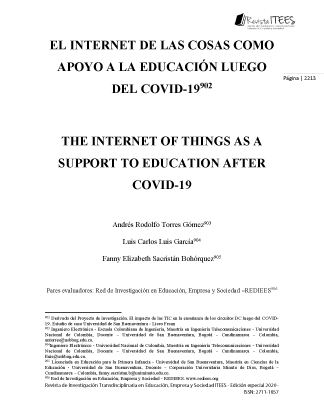CXVII. THE INTERNET OF THINGS AS A SUPPORT TO EDUCATION AFTER COVID-19
##plugins.themes.bootstrap3.article.main##
Abstract
Considering the global quarantine situation due to COVID-19, educational institutions have
modified teaching-learning methodologies to reach their students; For this, different
strategies have been used where the use of technology as the main ally has prevailed. In this
research, two specific models used by the University of San Buenaventura in Bogotá are
identified and analyzed, specifically in the DC Circuits subject, electronic engineering
program, and the Liceo Fesan in the tenth and eleventh grades for the area of teaching basic
electronics and general recommendations are made to strengthen the teaching-learning
process, considering the needs that can generate a cause of health emergency worldwide.
For this purpose, the models used before and after quarantine are determined, focused on
their didactics and evaluation activities. It was observed that the face-to-face classes were
replaced by synchronous and asynchronous virtual sessions and the face-to-face laboratory
practices by practices carried out in simulators. The results obtained in the evaluation were
generally better than those of the face-to-face sessions. The need for stable internet
connections and adequate bandwidths as well as the implementation of simulators is
determined.
Download Statistics
##plugins.themes.bootstrap3.article.details##
internet of Things (IoT), education, technology, teaching, electronics
Bernal, C. (2016). Metodología de la Investigación. Colombia: Pearson.
Caballero López, J. E. (2009, 09). http://scielo.isciii.es. Retrieved from
https://bit.ly/34VaU3p
Hernández, R., Fernández, C., & Baptista, P. (2003). Metodología de la investigación.
México: Mc Graw-Hill.
John, A. (2016). Normas Básicas de Higiene del Entorno en la atención sanitaria. India:
Organizacion Mundial de la Salud. Retrieved from https://bit.ly/3lt0QUT
Lewin, K. (1946). Action research and minority problems. Journal for Social Issues, 34 - 46.
Weiser, M. (1991). The computer for the 21st century. Scientific American, 265 - 94 - 104.





